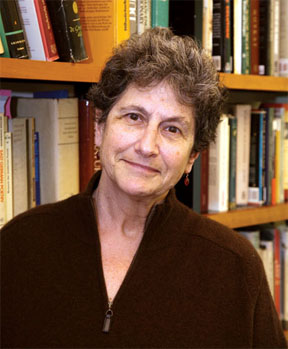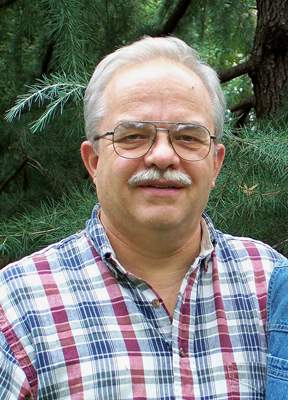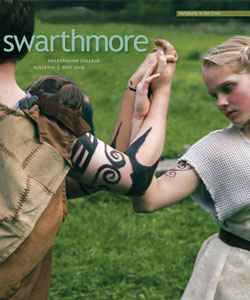Faculty Retirements
A Love of All Things Swarthmore
MARION FABER
It hardly seems possible that Marion Faber, Scheuer Family Professor of Humanities, has bid farewell to the College. In May, a full wall of books was neatly arranged in her office in Kohlberg Hall, family photos were gathered on the corner of her desk, and artwork was thoughtfully grouped on one wall. Four books lay open on the desk—a German-German dictionary, a German-English dictionary, an English dictionary, and a thesaurus, indicating that the prolific writer and translator was in the midst of another translation.
For 30 years, Faber has been happily ensconced at Swarthmore—teaching German literature and culture and developing interdisciplinary courses in film studies, women’s studies, Holocaust studies, and comparative literature. Since her arrival, the Department of Modern Languages and Literature has doubled in size and there is a greater emphasis on cultural courses within the study of languages and literature. “Marion has been the anchor of our program for a long time,” says Professor of German Hansjakob Werlen. “She is a gifted and enthusiastic teacher who loved her students and was, in turn, adored by them.”
“I’m the luckiest person on earth to have landed at Swarthmore,” Faber says. “It fits me to a ‘T.’ I most appreciate the students—they give me energy. They’re intellectually enthusiastic and serious, witty, and almost invariably a pleasure to teach.”
German history and culture—especially literature and music from the 18th century to the present—have been at the center of the California native’s scholarly life. Her love for the German language began when she was 16 and spent a summer in Hannover, Germany, as an exchange student. She has devoted her academic life to writing—Rudolf Serkin: A Life, a book she co-authored with Stephen Lehmann, the humanities bibliographer at Penn’s Van Pelt-Dietrich Library, was described by music critic Richard Dyer as “the best book about a pianist since Joseph Horowitz’s [’70] Conversations with Arrau two decades ago.” And translations—most notably of Wolfgang Hildesheimer’s Mozart, a study of the composer, and of Friedrich Nietzsche’s work—have immersed her in German arts and philosophy.
While Faber served as associate provost from 1989 to 1992, she helped create a new-faculty orientation program and was director of the Scholar-in-Residence Program of the Consortium for a Strong Minority Presence at Liberal Arts Colleges. She also was department chair from 1995 to 1998. Alan Berkowitz, Susan W. Lippincott Professor of Modern Classical Languages, describes Faber as attentive and truly “simpatica” as a colleague, who helped to steer the department through two near-schismatic junctures. “It was due largely to Marion’s calm deliberations and personal exchanges on deeply divisive personnel matters,” he says, “that the department did not swoon.”
Faber, who with husband Stephen Hannaford—who is not retiring—plans to spend a few more years in Swarthmore, says, “I prefer to precede details about retirement plans with the words “I hope.” A serious pianist, Faber hopes to get back into good shape on the piano. Beyond that, she says, “I hope to pursue my interests and to be useful.”
Taking His Life’s Work into Retirement
FRED ORTHLIEB
“I didn’t intend to be a professor,” says Fred Orthlieb, Isaiah V. Williamson Professor of Civil and Mechanical Engineering, “but it’s been a good run.” The 34 years he has spent immersed in College life and his plans for more of the same during retirement speak volumes about the Wallingford resident’s satisfaction with his life’s work.
For Orthlieb, the students are the best thing about teaching at Swarthmore. “So many of our students have wonderful potential and are special people,” he says. “I am glad to have been part of their education.”
Art McGarity, Henry C. and J. Arthur Turner Professor of Engineering, says that Orthlieb’s enthusiastic hands-on approach to engineering has had a wonderful influence on countless Swarthmore students. “They have learned,” says McGarity, “that classroom theory can really be used to solve difficult problems that affect people’s lives.”
A designer rather than an analyst, Orthlieb has used his practical skills to improve the Engineering Department’s instructional facilities, including two iterations of the Solar Lab, a Mechanics and Materials Lab in Papazian, a 50-ton “homemade” extrusion press that is used for research, and, just this past semester, a golf-ball–throwing trebuchet for an E6 dynamics lab powered by slabs of lead that were cast in his garage.
Professor of Engineering E. Carr Everbach describes Orthlieb as a walking encyclopedia of engineering esoterica. “If you want to know the pitch of left-handed turnbuckles or why the Schedule 40 pipe is called that, he’s your man,” Everbach says. “On the other hand, Fred comes up with very creative design solutions to every conceivable type of problem. I’ll miss having his perspective.”
One high point of Orthlieb’s work with his students has been the E [Entrepreneurial]-Team Off-Grid Domestic Heating System project that began in 1996. In spring 2001, a $14,000 National Collegiate Inventors and Innovators Alliance grant funded the work of then engineering seniors Tushar Parlikar ’01 and Ari Houser ’01 and a marketing team of economics and political science majors in developing a prototype minimum-power home heating system. Orthlieb is involved in getting the system—which was granted a patent in 2004 and can heat a house without grid power for several days—to market. He is also part of a team that is developing the first oil-fired, hot water system prototype—a project that he is taking with him into retirement.
Two other retirement take-alongs are an NIH proposal to develop the off-grid system for gas-fired hot water, and a summer project to restore and upgrade the 1887, 10-inch Clark refracting telescope at Bucknell University. Orthlieb has been restoring telescopes since 2005—including the superb 1931 Zeiss Urania refractor at the Franklin Institute’s Bloom Observatory—with Christopher Ray, former science museum exhibit designer and longtime preserver of the 24-inch refractor in Sproul Observatory.
Orthlieb is also licensed pilot and certified SCUBA diver—and for many years was the only faculty member who owned (and rode) a motorcycle. For now, while his wife, Vera, continues to work as a librarian, he will stay close to home with his engineering projects.
 Email This Page
Email This Page

